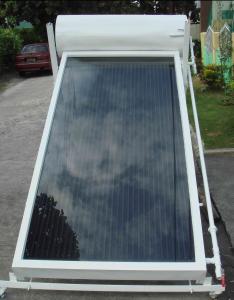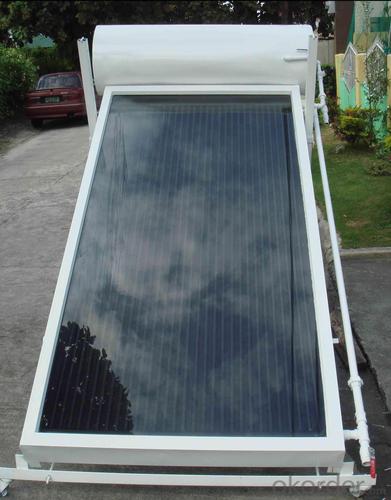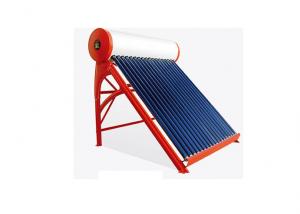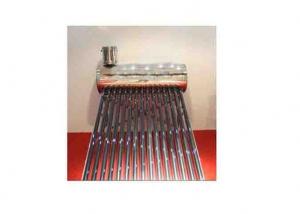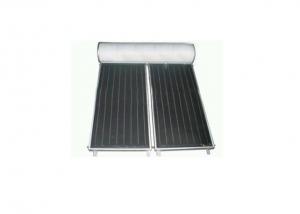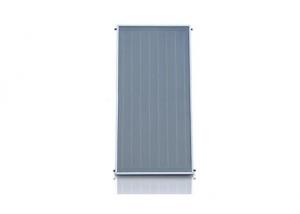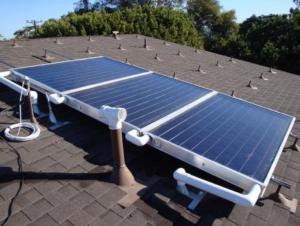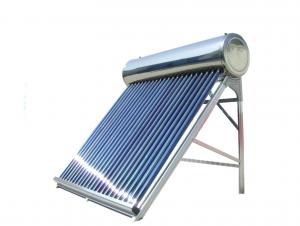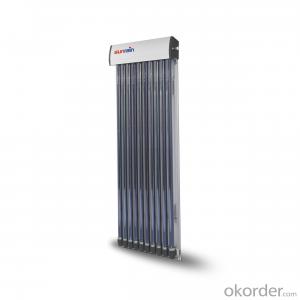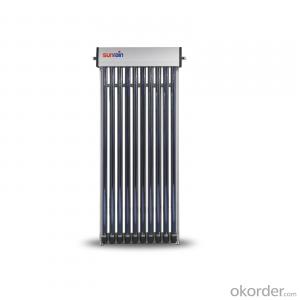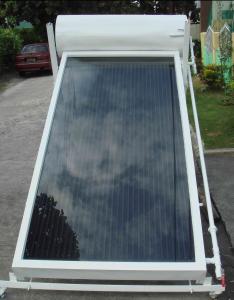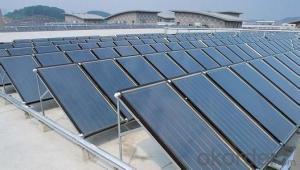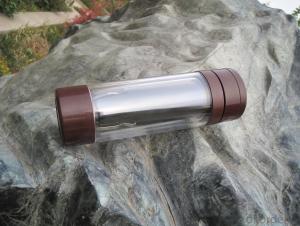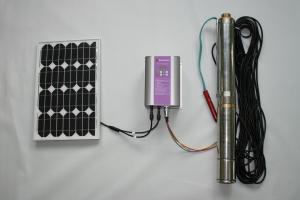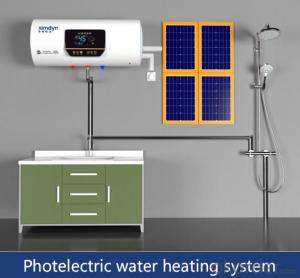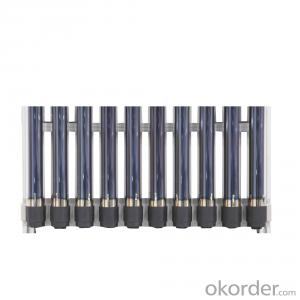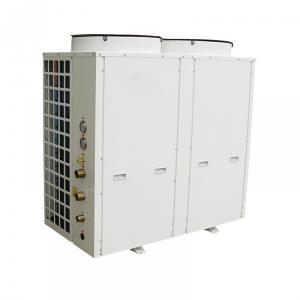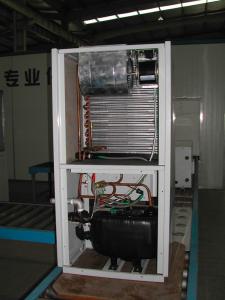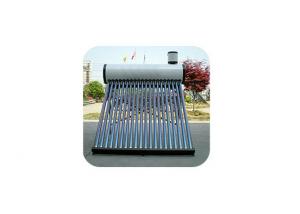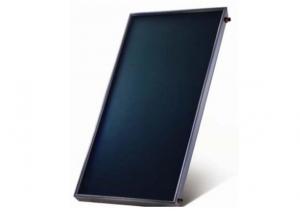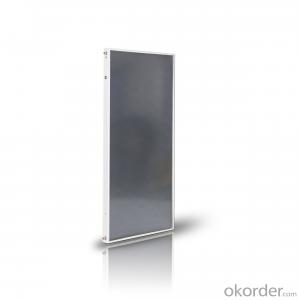GE Solar Water Heater FS-NPTS Series
- Loading Port:
- SHENZHEN Port
- Payment Terms:
- 100%TT
- Min Order Qty:
- 1000 UNITS unit
- Supply Capability:
- 1-10000 unit/month
OKorder Service Pledge
OKorder Financial Service
You Might Also Like
Details Of Solar Water Heater FS-NPTS Series
Specifications Of Solar Water Heater FS-NPTS Series
Model No.&Specs | FS-NPTS-200 | |
Solar collector | Absorber material | Black chrome coating,whole plate by laser welding |
Dimension LxWxT | 2000*1250*95mm | |
Overall area | 2.5m 2 X1pcs | |
Absorption | 95% | |
Emittance | ≤11% | |
Water Tank | Circulation Type | Non-pressurized open loop |
Tank capacity | 200L | |
External dimension | Ø525x1620mm | |
Outer tank material | Aluzinc Steel | |
Inner tank material | SUS304-2B | |
Max working pressure | 0Mpa | |
Eelctric booster | 1.5kw Thermowatt | |
Mounting rack | Material | Galvanized steel |
Bracket style | A: flat roof or B:Sloping roof | |
Connections&Controller | Circulation pipe material | Stainless steel corrugated pipe(Ø22mm) |
Compression fittings | Ø22mm*G3/4" | |
Controller | Automatically control the electric heater and minitor the water temperature | |
Overall weight | Weight of overall system(empty)(kg) | 135 |
Weight of overall system(filled)(kg) | 345 | |
Container loading | 20' | 27sets |
40' | 54sets | |
Advantage Of Solar Water Heater FS-NPTS Series
1.Stylish slimline design
2.Save 55% to 85% of your water heating energy consumption
3.Reliable, low maintenance operation
4.Hot water regardless of the weather
5.Can qualify for valuable government environmental incentives
6.Reduced energy use saves up to 3.2 tonnes of CO2 emissions every year
Usage/Application OfSolar Water Heater FS-NPTS Series
Integrated solar water heater
For independent courtyards such as villa, vacation village, rural housing and flat-roof buildings on the groundfloor.
Packaging & Delivery Of Solar Water Heater FS-NPTS Series | |
Packaging Detai | Packaging Detail:Export Carton and Pallet or under customer request. |
Delivery Detail:10-20days | |
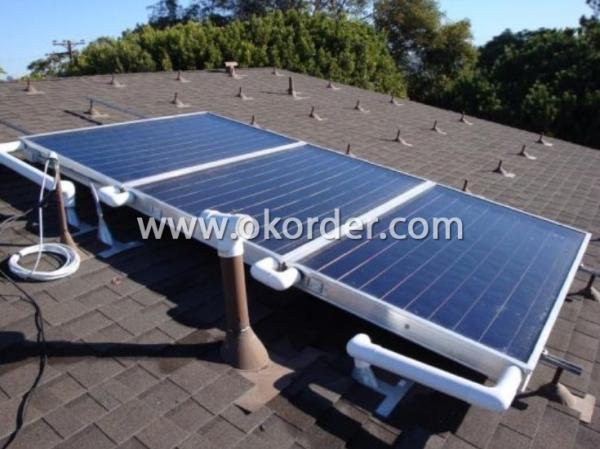
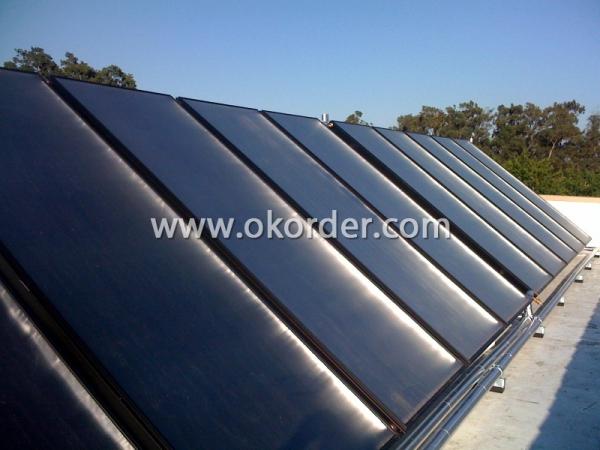
- Q: Can a solar water heater be used in areas with limited access to internet connectivity?
- Yes, a solar water heater can be used in areas with limited access to internet connectivity. Solar water heaters do not rely on internet connectivity for their operation. They function by utilizing solar energy to heat water, and their functionality is not dependent on internet access.
- Q: What are the installation requirements for a solar water heater's safety features?
- The installation requirements for a solar water heater's safety features vary depending on the specific model and local building codes. However, there are some common safety features that are generally required for the installation of a solar water heater. 1. Pressure Relief Valve: A pressure relief valve is a crucial safety feature that helps prevent excessive pressure buildup in the solar water heater system. It is typically installed on the storage tank and automatically releases water if the pressure exceeds a certain level, preventing potential damage or explosions. 2. Temperature and Pressure Gauge: A temperature and pressure (T&P) gauge is essential for monitoring the temperature and pressure within the solar water heater system. It helps ensure that the system operates within safe limits and allows users to identify any potential issues before they become more serious. 3. Backflow Prevention Device: To prevent the contamination of the potable water supply, a backflow prevention device is often required. It ensures that water from the solar water heater system does not flow back into the main water supply, which could potentially introduce harmful substances or bacteria. 4. Expansion Tank: Due to the expansion and contraction of the water as it heats up and cools down, an expansion tank may be necessary. It helps accommodate the increased volume of water and prevents excessive pressure buildup in the system, thus enhancing safety and protecting the components from damage. 5. Insulation and Ventilation: Proper insulation of pipes and components is crucial to prevent heat loss and potential burns. Additionally, adequate ventilation is necessary to avoid the buildup of flammable gases, such as hydrogen, that may be produced during the operation of the solar water heater. It is important to note that these are general safety features typically required for solar water heater installations, but specific requirements may vary depending on local regulations and the type of system being installed. It is recommended to consult with a professional installer or local authorities to ensure compliance with all safety requirements during the installation process.
- Q: Can a solar water heater be used in areas with limited sewage infrastructure?
- Yes, a solar water heater can be used in areas with limited sewage infrastructure. Unlike traditional water heaters that rely on fossil fuels or electricity, solar water heaters use the sun's energy to heat water. They consist of a solar collector that absorbs sunlight and converts it into heat, which is then transferred to the water. This process does not produce any waste or require any connection to a sewage system. In areas with limited sewage infrastructure, the use of solar water heaters can be highly beneficial. Since they do not produce any waste, there is no need for a sewage system to handle the discharged water. Instead, the heated water can be used directly for various purposes such as bathing, cleaning, or even for agricultural or industrial processes. This reduces the burden on the limited sewage infrastructure, preventing potential issues such as overflow or contamination. Furthermore, solar water heaters are typically designed to store and distribute hot water, which means they can provide a continuous supply of heated water even in areas with limited access to electricity. This can be particularly useful in remote or rural regions where electricity is unreliable or unavailable. Overall, the use of solar water heaters in areas with limited sewage infrastructure can provide a sustainable and cost-effective solution for accessing hot water without putting additional strain on the sewage system.
- Q: Air water heater advantages and disadvantages?
- 1 advantages: environmental protection and energy saving, because air heaters can not use gas, will not produce gas, so as not to destroy the ozone layer, but also because it saves the electricity, and reduce the consumption of electricity per time, can reduce the power of the 1.5 pounds of carbon dioxide, also can reduce the damage to the ozone layer. Therefore, the use of air heaters can also delay the warming of the earth"
- Q: Can a solar water heater be used in areas with limited access to financial resources for installation or maintenance?
- Areas with limited access to financial resources for installation or maintenance can still benefit from the use of a solar water heater. Solar water heaters have several advantages that make them suitable for such areas. To begin with, solar water heaters make use of renewable energy from the sun, which is available for free in almost all parts of the world. This eliminates the need for expensive fossil fuels or electricity, making it a cost-effective solution for those with limited financial resources. Furthermore, solar water heaters have a relatively simple design and can be easily constructed using locally available materials. There are different types of solar water heaters, such as batch heaters, flat-plate collectors, and evacuated tube collectors. Depending on the specific requirements and available resources, a suitable design can be chosen and built with minimal investment. Additionally, solar water heaters require low maintenance. Basic cleaning and periodic checks are usually sufficient to ensure proper functioning. This can be done by the users themselves or by trained technicians from the community, reducing the need for expensive professional maintenance services. Moreover, there are numerous organizations and initiatives that aim to promote the use of solar energy in areas with limited financial resources. These organizations often provide financial assistance or subsidies for the initial installation cost, making it more affordable for the communities. In conclusion, solar water heaters can be a viable option for areas with limited access to financial resources for installation or maintenance. They provide a sustainable and cost-effective solution for heating water, improving the quality of life for communities by providing hot water for various domestic purposes.
- Q: Can a solar water heater be used in areas with limited oil availability?
- In areas with limited oil availability, a solar water heater proves to be a viable option. Unlike traditional water heaters that rely on oil or other fossil fuels, solar water heaters primarily utilize the sun's energy. As a result, they serve as an excellent alternative in regions where oil availability is constrained or unpredictable. These water heaters are specifically designed to capture and convert sunlight into heat, which is then used to warm the water stored within the system. This design promotes sustainability and environmental friendliness, reducing reliance on oil and mitigating greenhouse gas emissions. Moreover, solar water heaters offer particular advantages in remote or off-grid locations where accessing oil may present challenges or incur high costs. By harnessing the abundant and free energy from the sun, these water heaters provide a dependable and efficient solution for heating water in areas with limited oil availability.
- Q: How does a solar water heater affect the water temperature?
- Water is heated by a solar water heater through the utilization of solar energy. This system typically comprises a collector that absorbs sunlight and converts it into heat, and a storage tank where the heated water is stored for later use. The solar collector, usually consisting of dark-colored tubes or panels, absorbs the sun's energy and transfers it to the water as it passes through. This process increases the water temperature to a desired level for various purposes, such as showers, baths, or other household needs. The efficiency of a solar water heater is influenced by factors such as sunlight availability, collector size and design, and storage tank insulation. Under optimal conditions, it can effectively raise the water temperature, providing hot water for diverse applications. Nevertheless, it should be noted that solar water heaters may not be able to achieve extremely high water temperatures, particularly during periods of limited sunlight or in colder climates. In such instances, a backup heating system, such as an electric or gas heater, may be necessary to ensure a continuous supply of hot water. In conclusion, a solar water heater can make a significant difference in water temperature by utilizing renewable energy sources, reducing reliance on traditional heating methods, and resulting in energy and cost savings while also being environmentally friendly.
- Q: Can a solar water heater be used in areas with limited access to hot water?
- Yes, a solar water heater can be used in areas with limited access to hot water. Solar water heaters use sunlight to heat water, making them a sustainable and energy-efficient option. They can be particularly beneficial in areas where traditional sources of hot water may be scarce or unreliable. By harnessing solar energy, these heaters provide a renewable and cost-effective solution for obtaining hot water in regions with limited access to it.
- Q: What are the common repair issues with a solar water heater?
- The common repair issues with a solar water heater include leaks or damaged pipes, malfunctioning valves or controls, faulty sensors or thermostats, and issues with the heat exchanger or pump. Additionally, sediment buildup or scaling in the system can affect its efficiency and require maintenance. Regular inspections and proper maintenance can help identify and address these issues promptly.
- Q: Can a solar water heater be used in areas with limited access to carbon footprint calculations?
- Yes, a solar water heater can be used in areas with limited access to carbon footprint calculations. The primary advantage of solar water heaters is their ability to harness clean and renewable energy from the sun, reducing reliance on fossil fuels and minimizing carbon emissions. Even without precise calculations, it is evident that utilizing solar energy for water heating can significantly reduce the carbon footprint compared to conventional heating methods. Hence, solar water heaters are a viable and eco-friendly solution for areas without extensive carbon footprint calculations.
1. Manufacturer Overview
| Location | Guangdong,China |
| Year Established | 1990 |
| Annual Output Value | Below US$1 Million |
| Main Markets | WORLDWIDE |
| Company Certifications |
2. Manufacturer Certificates
| a) Certification Name | |
| Range | |
| Reference | |
| Validity Period |
3. Manufacturer Capability
| a) Trade Capacity | |
| Nearest Port | GUANGDONG,SHENZHEN |
| Export Percentage | 61% - 70% |
| No.of Employees in Trade Department | more than 200 |
| Language Spoken: | English, Chinese |
| b) Factory Information | |
| Factory Size: | 500 square kilometre |
| No. of Production Lines | 2 |
| Contract Manufacturing | |
| Product Price Range | |
Send your message to us
GE Solar Water Heater FS-NPTS Series
- Loading Port:
- SHENZHEN Port
- Payment Terms:
- 100%TT
- Min Order Qty:
- 1000 UNITS unit
- Supply Capability:
- 1-10000 unit/month
OKorder Service Pledge
OKorder Financial Service
Similar products
Hot products
Hot Searches
Related keywords
